22 Jun 2017 | Focolare Worldwide
Listening to one another.This was the spirit with which Gabriela Melo and Augusto Parody of the Focolare International Centre set out on their journey to visit the many communities of the Movement diffused in Latin America. They even reached Esmeraldas in Ecuador, on the Pacific Coast, populated mostly by Afro-Ecuadorians, and where the crystalline blue of the sky merges with that of the sea, making the luxuriant vegetation shine like an emerald. This enchanting landscape changes suddenly the minute you enter the town, and especially the view ends with the conglomerations of bamboo and galvanized iron huts in the poor districts like Isla Bonita, Pampon, and Puerto Limon.. The hordes of children play on the streets and on the beach from morning till night, and if they are not saved on time as adolescents and teenagers, they become drug or alcohol addicts, involved in “pandillerism” (the infamous metropolitan gangs of marauders). The spirituality of unity reached Esmeraldas over 30 years ago, and took root precisely among the Afro-Ecuadorian population of families, youths, priests and children who have made the evangelical news of mutual love the law of their lives. It is a ray of spirituality that has lighted up new hope, putting into action new ideas and forces. And this is what happened around Fr. Silvino Mina, who is also part of the community. Through the Ayudav group that formed in his parish he was able to solve many urgent cases of street children and teens, giving rise to the need of reinforcing these aid actions, also by calling the attention of the Institutions. This was how the Fundación Amiga (1992) was born, and with it, a school for kids at risk, with the aim of making their lives more dignified and helping them to face the future through suitable educational programmes. By focusing on their great sportive talents (Esmeraldas is infact known as the cradle of Ecuadorian athletes), they formed a soccer school, and also handicraft laboratories run by the former street youths themselves. «Today, the school has1,700 children and adolescents from 13 to 19 years of age – Don Silvino explained – and with global educational projects, where one tries to put into practice what one learns, the whole educational community of students, teachers and parents is involved. All the children are offered a good meal a day, which for many is the only meal they can afford, together with vaccinations, medical treatments and education on health and Aids prevention. We also study the Afro culture and traditions, and not only these.» Ecuador, in fact, is a crossroad of millenary cultures (Quito was one of the two ancient capitals of the Incas) where they spoke various Amerinde languages (Quechua, Shuar, Tsafiki and others). The government’s endeavour precisely aims to recover local communities, cultures and religious expressions, to establish a dialogue which valorises their diversities in an enriching intercultural experience. This term appears at least eleven times in the new Constitution approved in 2008.«And if we added the socio-political demands–Gabriela and Augusto observed – we could also highlight what is happening in Esmeraldas, the commitment to live the Gospel, and the building of communities where the different ethnic, linguistic and religious components trigger a daily process of integration which is spreading quickly. This is a process which benefits the big intercultural workshop which is Eduador, a country that can really offer the world a unique and sustainable model of encounter and coexistence.»
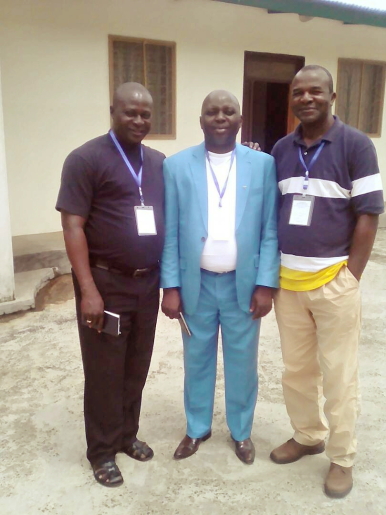
21 Jun 2017 | Focolare Worldwide
 “Even if it is not officially declared, also here we are fighting the ‘third piecemeal war’. The transitional government is trying to rebuild what the recent civil war has demolished, but has to contend with the strife that often breaks out into fratricide struggles.” Martial Agouais a Catholic priest of the Central African Republic, a country where the majority are Christians and 15% are Muslims. In the absence of a national defense body, the UN sent the peacekeepers, called the “blue helmets”, of some foreign contingents, but there are many interests at stake. The perpetration of the guerilla paradoxically acts also as a cover for foreign hoarders, greedy forthe country’s precious mineral resources. Enemy hunts are always ongoing, and often are fatally found in the tribe right in front, or in the village which practices another religion. The recent news reported about a Catholic bishop, Bishop Juan José Aguirre Muñoz who opened his parish in Tokoyo to host 2,000 Muslims under the attack of the anti-Balaka, also called Christian militias, originally formed as a sort of self-defence groups of the Islamic Seleka gangs, but which lately have often become terrorist groups. This has made no difference between the violent groups who had triggered the revolt, and the civil Muslims, peace-loving people of merchants and the Peul tribe (nomadic cattlemen, also called Mbororo). “My parish,” recounted Fr Martial, “dedicated to the Holy Family, is in Sibut, the capital of the KemoInbingu region. Here in Sibut a meeting of all the authorities was held recently, from the prefect to the mayor, the tribe chiefs of the Munisca force to the district chiefs of the Burundi contingent, and the ex-Selekato the anti-Balaka. At a certain point the chief of the anti-Balakaspoke up to say in a loud voice that the pastors of the various churches, priests, religious men and women must no longer speak about social issues in the churches. All were scared and nobody dared to contradict him. Also I didn’t speak, but that threat did not stop my Christian commitment. I had learned from the spirituality of the Focolare that we have to love everyone, and be concerned about the rights of all. And I said to myself, if I have to choosewhat side to take, I will always choose to stand by the weaker people, the most defenceless.” Two days later, the Peuls were attacked by the anti-Balakain the forest where they were pasturing their cattle, at 18 km along the Bangui axis. Four men were killed and seven among the women and children were wounded. The Munisca brought the wounded to the central hospital of Sibut, but for two days they did not receive any treatment or food. Everyone was afraid to approach them to help them, including the NGOs and the humanitarian services. “When I found out about the situation,” the priest explained, “I took courage and went to the chief of the anti-Balakato ask him to accompany me to the hospital. Upon seeing those wounded Muslims left to themselves in a room with an unbearable smell and in pitiful conditions, both of us were moved to tears. I ran to some Christian families living close to the hospital to ask for water for drinking and to wash them, and also food. I then obtained from the diocesan Caritas director, a means of transport that would bring them to Bangui, 200 km away. Thank God, in three weeks all of them were healed and the Caritas was able to bring them home to their families safe and sound.” Abbé Martial Agoua – Sibut (R.C.A.)
“Even if it is not officially declared, also here we are fighting the ‘third piecemeal war’. The transitional government is trying to rebuild what the recent civil war has demolished, but has to contend with the strife that often breaks out into fratricide struggles.” Martial Agouais a Catholic priest of the Central African Republic, a country where the majority are Christians and 15% are Muslims. In the absence of a national defense body, the UN sent the peacekeepers, called the “blue helmets”, of some foreign contingents, but there are many interests at stake. The perpetration of the guerilla paradoxically acts also as a cover for foreign hoarders, greedy forthe country’s precious mineral resources. Enemy hunts are always ongoing, and often are fatally found in the tribe right in front, or in the village which practices another religion. The recent news reported about a Catholic bishop, Bishop Juan José Aguirre Muñoz who opened his parish in Tokoyo to host 2,000 Muslims under the attack of the anti-Balaka, also called Christian militias, originally formed as a sort of self-defence groups of the Islamic Seleka gangs, but which lately have often become terrorist groups. This has made no difference between the violent groups who had triggered the revolt, and the civil Muslims, peace-loving people of merchants and the Peul tribe (nomadic cattlemen, also called Mbororo). “My parish,” recounted Fr Martial, “dedicated to the Holy Family, is in Sibut, the capital of the KemoInbingu region. Here in Sibut a meeting of all the authorities was held recently, from the prefect to the mayor, the tribe chiefs of the Munisca force to the district chiefs of the Burundi contingent, and the ex-Selekato the anti-Balaka. At a certain point the chief of the anti-Balakaspoke up to say in a loud voice that the pastors of the various churches, priests, religious men and women must no longer speak about social issues in the churches. All were scared and nobody dared to contradict him. Also I didn’t speak, but that threat did not stop my Christian commitment. I had learned from the spirituality of the Focolare that we have to love everyone, and be concerned about the rights of all. And I said to myself, if I have to choosewhat side to take, I will always choose to stand by the weaker people, the most defenceless.” Two days later, the Peuls were attacked by the anti-Balakain the forest where they were pasturing their cattle, at 18 km along the Bangui axis. Four men were killed and seven among the women and children were wounded. The Munisca brought the wounded to the central hospital of Sibut, but for two days they did not receive any treatment or food. Everyone was afraid to approach them to help them, including the NGOs and the humanitarian services. “When I found out about the situation,” the priest explained, “I took courage and went to the chief of the anti-Balakato ask him to accompany me to the hospital. Upon seeing those wounded Muslims left to themselves in a room with an unbearable smell and in pitiful conditions, both of us were moved to tears. I ran to some Christian families living close to the hospital to ask for water for drinking and to wash them, and also food. I then obtained from the diocesan Caritas director, a means of transport that would bring them to Bangui, 200 km away. Thank God, in three weeks all of them were healed and the Caritas was able to bring them home to their families safe and sound.” Abbé Martial Agoua – Sibut (R.C.A.)

19 Jun 2017 | Focolare Worldwide
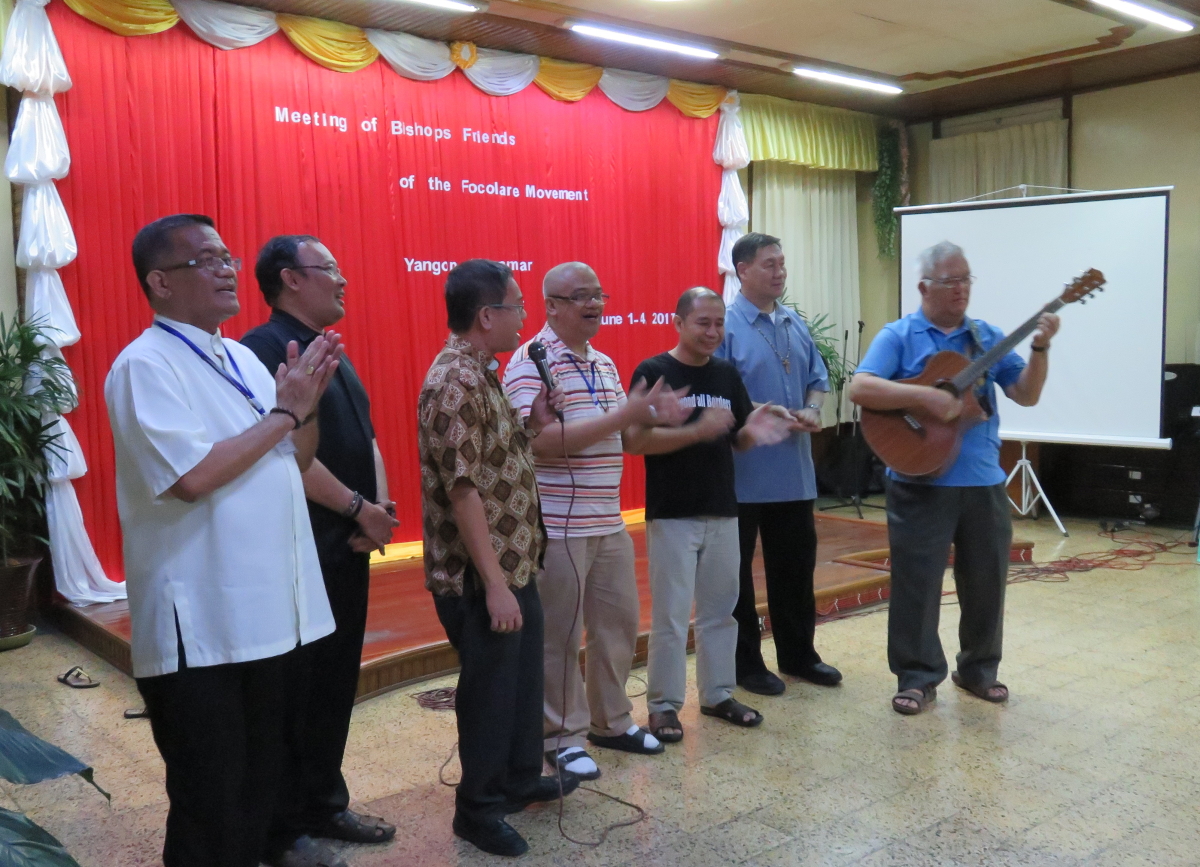 “That all may be one. We were born for these words of unity, to contribute to making it a reality in the world.” The words of Chiara Lubich, commented on by Bishop Felix Liam, President of the Episcopal Conference of Myanmar, on the first day of the meeting (1- 4 June 2017), well evidenced the aim of the convention held this year in Yangon, Myanmar, a country in Southeast Asia, on the western side of Indochina. These conventions held every year at international, ecumenical and regional levels,began about 40 years ago on the initiative of Chiara Lubich and Klaus Hemmerle (1929-1994), then Bishop of Aachingen, (Germany).. In Yangon, with a strong presence of the episcopate of Myanmar (19 bishops), there was a warm family atmosphere. Among the 31 participants,a good number came from the Philippines, India, Malaysia and South Korea. In communicating his experience on his encounter with the spirituality of unity, Cardinal Francis Xavier Kriengsak of Bangkok, moderator of the bishop-friends of the Focolare, invited the bishops to discover and deepen one of the fundamental points of the spirituality of unity: Jesus crucified and abandoned, and place it in the centre of their lives in order to become instruments of communion in the Church and humanity. This was also testified to by the experience of the members of the local community of the Focolare who had prepared to welcome the bishops in the best way possible. But also some bishops, like the Irish Bishop Brendan Leahy, see in the mystery of Jesus forsaken, the “countenance of mercy, key to dialogue and unity, and pathway to the sanctity of the people.” The life of Bishop Klaus Hemmerle was conveyed through a PowerPoint presentation and brief videos that showed the amazing fruitfulness of love for Jesus Forsaken even in the most “critical” situations. The themes on Evangelisation and Inculturation in the spirituality of unity were very actual and trigged particular interest in a country which is mostly Buddhist.
“That all may be one. We were born for these words of unity, to contribute to making it a reality in the world.” The words of Chiara Lubich, commented on by Bishop Felix Liam, President of the Episcopal Conference of Myanmar, on the first day of the meeting (1- 4 June 2017), well evidenced the aim of the convention held this year in Yangon, Myanmar, a country in Southeast Asia, on the western side of Indochina. These conventions held every year at international, ecumenical and regional levels,began about 40 years ago on the initiative of Chiara Lubich and Klaus Hemmerle (1929-1994), then Bishop of Aachingen, (Germany).. In Yangon, with a strong presence of the episcopate of Myanmar (19 bishops), there was a warm family atmosphere. Among the 31 participants,a good number came from the Philippines, India, Malaysia and South Korea. In communicating his experience on his encounter with the spirituality of unity, Cardinal Francis Xavier Kriengsak of Bangkok, moderator of the bishop-friends of the Focolare, invited the bishops to discover and deepen one of the fundamental points of the spirituality of unity: Jesus crucified and abandoned, and place it in the centre of their lives in order to become instruments of communion in the Church and humanity. This was also testified to by the experience of the members of the local community of the Focolare who had prepared to welcome the bishops in the best way possible. But also some bishops, like the Irish Bishop Brendan Leahy, see in the mystery of Jesus forsaken, the “countenance of mercy, key to dialogue and unity, and pathway to the sanctity of the people.” The life of Bishop Klaus Hemmerle was conveyed through a PowerPoint presentation and brief videos that showed the amazing fruitfulness of love for Jesus Forsaken even in the most “critical” situations. The themes on Evangelisation and Inculturation in the spirituality of unity were very actual and trigged particular interest in a country which is mostly Buddhist. 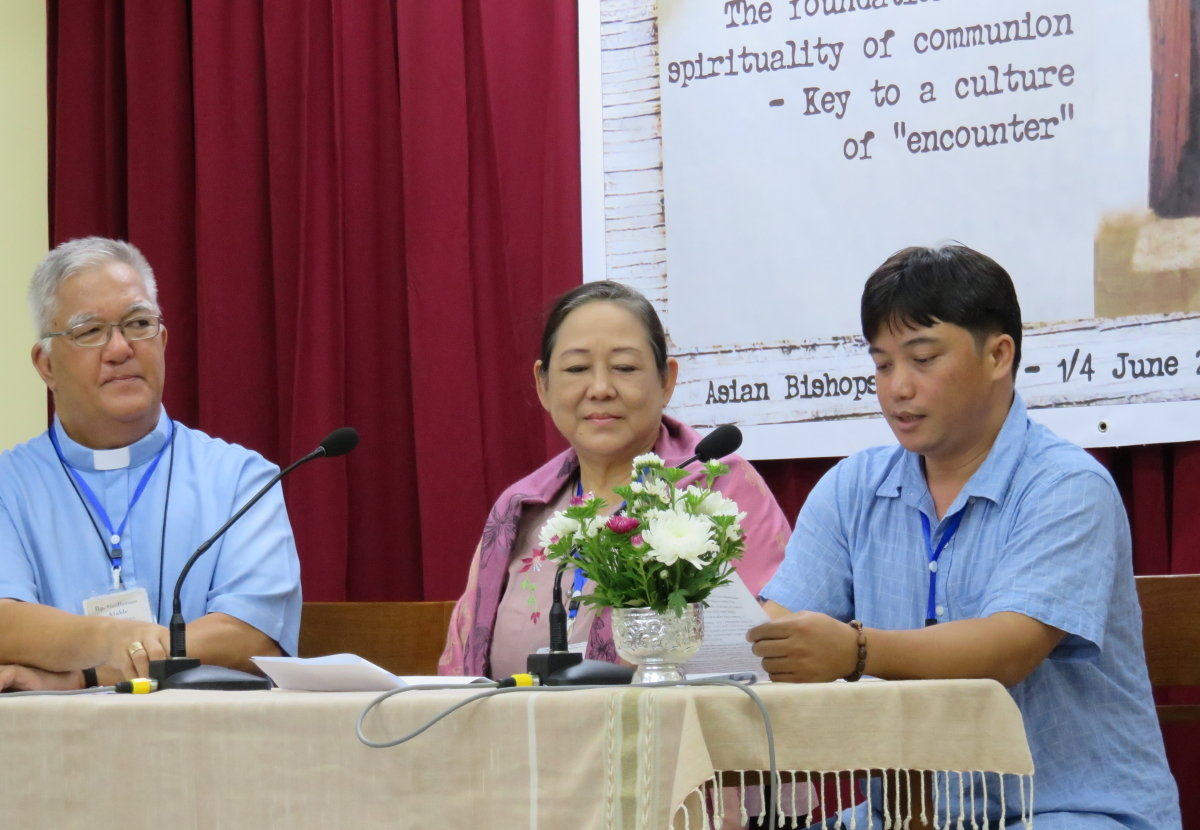 The story of Chiara Lubich and the Movement she had given life to, along with the experiences of the members of the local community, was very moving. Cardinal Carlo Bo, archbishop of Yangon said: “I was very impressed by the story of the charismatic and prophetic life of the founder of the movement. More than ever the Church needs movements like the Focolare. While the arrogance of power divides people according to colour and race, Chiara created a global communion for worldwide peace.” Bishop Matthias (Myanmar) commented: “When one usually participates in the meeting of bishops, we listen to many things, but on an intellectual level. Instead, here we talk about life and we see happy people.»And Bishop Isaac (Myanmar):“The life of a bishop is not easy, and we ourselves often feel abandoned. Now that I have met Jesus Forsaken, I will have the strength and the light to go ahead.” From Korea, Bishop Peter added: «It is the first time for me to participate in a meeting of bishops. Here I saw people who try to love Jesus Forsaken in every difficulty; people who are behind the wings, try to serve all of us,» referring to the members of the local community of the Movement. Openness to cultural and interreligious dialogue was assumed in the golden colours of the Pagoda of Shwedagon, the most important and renowned in the capital, and in which the relics of the four Buddhas are jealously guarded. The visit to this sacred place on the hill of Singuttara, to the west of Royal Lake, was a symbol of respect for the Buddhist soul and the culture of the place. At the top of the Pagoda, a banner-like anemoscope scattered with precious stones, displays the direction of the wind. If sufficiently supported, its fluttering is accompanied by the sound of tiny bells. The Myanmar bishops are certain of which direction the wind is blowing: in the direction of unity, towards a Church which is increasingly a witness of “communion”.
The story of Chiara Lubich and the Movement she had given life to, along with the experiences of the members of the local community, was very moving. Cardinal Carlo Bo, archbishop of Yangon said: “I was very impressed by the story of the charismatic and prophetic life of the founder of the movement. More than ever the Church needs movements like the Focolare. While the arrogance of power divides people according to colour and race, Chiara created a global communion for worldwide peace.” Bishop Matthias (Myanmar) commented: “When one usually participates in the meeting of bishops, we listen to many things, but on an intellectual level. Instead, here we talk about life and we see happy people.»And Bishop Isaac (Myanmar):“The life of a bishop is not easy, and we ourselves often feel abandoned. Now that I have met Jesus Forsaken, I will have the strength and the light to go ahead.” From Korea, Bishop Peter added: «It is the first time for me to participate in a meeting of bishops. Here I saw people who try to love Jesus Forsaken in every difficulty; people who are behind the wings, try to serve all of us,» referring to the members of the local community of the Movement. Openness to cultural and interreligious dialogue was assumed in the golden colours of the Pagoda of Shwedagon, the most important and renowned in the capital, and in which the relics of the four Buddhas are jealously guarded. The visit to this sacred place on the hill of Singuttara, to the west of Royal Lake, was a symbol of respect for the Buddhist soul and the culture of the place. At the top of the Pagoda, a banner-like anemoscope scattered with precious stones, displays the direction of the wind. If sufficiently supported, its fluttering is accompanied by the sound of tiny bells. The Myanmar bishops are certain of which direction the wind is blowing: in the direction of unity, towards a Church which is increasingly a witness of “communion”.

17 Jun 2017 | Focolare Worldwide
 My path began on the last day of the Rwandan calendar, the day in which we remember the massacre that happened in 1994. I know that Jesus Forsaken can give meaning to every human suffering, especially the ones that leave the deepest wounds in our hearts. I sense a profound bond between the sacrifice of Jesus and the pain and suffering of the Rwandan people. Under the guidance of Father Telesphore, a local priest, he became acquainted with the capital city of Kigali known for its attractiveness. The signs of economic growth, however, can especially be seen in the centre of the city which looks like a European capital. But not far from the modern buildings there are the common folk, bound to agriculture and selling their products at market: fruit, vegetables, chickens, and so forth. Due to my white skin and tall stature, my presence doesn’t go by unnoticed. I encounter many surprised faces, but it’s enough to offer a greeting of “muraho” or a smile and the ice melts into a nice smile. We visit the main cities of the country by car, stopping now and then to give someone a ride. I was particularly struck by one young woman around 20 years old. Behind her pretty smile was a painful story. Fr Telesphore tells me that her parents were killed in the 1990 genocide. She had just been to their tomb where she went to pray. She and her young brother have been visiting Father Telesphore since they were young. They found a family that filled them with love. I met many other people in situations that were similar to theirs. We spent Saturday at the seminary school of theology which takes in 130 seminarians from around the country. At the Mass, which was imbued with Rwandan culture, I was very touched by the Thanksgiving After Communion with songs that engaged the whole assembly. It was like a sacred rythm, not perfectly synchronized, but incredibly harmonic. At one seminary we held a “school” for seminarians who wanted to know about the spirituality of unity. Right from the start, Father Telesphore clarified for everyone that “this school is not run with books, but with life” and that “we’re here to build the unity Jesus desired, through our reciprocal love.” The Gospel love among everytone could be felt in very strong and concrete ways throughout the meeting. After a basketball match, I found myself asking who had won? The answer: everybody. Where there’s love, competition becomes an occasion to live the Gospel. We focused on the mystery of Jesus Forsaken, which is one of the points of the spirituality of unity. We were all moved by the testimony of two priests, one from Rwanda and the other from Burundi, lands that are marked by mutual misunderstandings. But through love towards Jesus in his abandonment, those misunderstandings gave way to unity between the two priests. One of the seminarians spoke for everyone: “When you speak with the heart, you touch us in the heart.” The last days were dedicated to meeting with families and young people, but also other people who share the ideal of fraternity. We concluded with a pilgrimage to the Shrine of Our Lady, which was not far from the seminary. We wanted to thank her for this trip and for the immeasureable gifts we all recevied. (Armando A. – Brazil)
My path began on the last day of the Rwandan calendar, the day in which we remember the massacre that happened in 1994. I know that Jesus Forsaken can give meaning to every human suffering, especially the ones that leave the deepest wounds in our hearts. I sense a profound bond between the sacrifice of Jesus and the pain and suffering of the Rwandan people. Under the guidance of Father Telesphore, a local priest, he became acquainted with the capital city of Kigali known for its attractiveness. The signs of economic growth, however, can especially be seen in the centre of the city which looks like a European capital. But not far from the modern buildings there are the common folk, bound to agriculture and selling their products at market: fruit, vegetables, chickens, and so forth. Due to my white skin and tall stature, my presence doesn’t go by unnoticed. I encounter many surprised faces, but it’s enough to offer a greeting of “muraho” or a smile and the ice melts into a nice smile. We visit the main cities of the country by car, stopping now and then to give someone a ride. I was particularly struck by one young woman around 20 years old. Behind her pretty smile was a painful story. Fr Telesphore tells me that her parents were killed in the 1990 genocide. She had just been to their tomb where she went to pray. She and her young brother have been visiting Father Telesphore since they were young. They found a family that filled them with love. I met many other people in situations that were similar to theirs. We spent Saturday at the seminary school of theology which takes in 130 seminarians from around the country. At the Mass, which was imbued with Rwandan culture, I was very touched by the Thanksgiving After Communion with songs that engaged the whole assembly. It was like a sacred rythm, not perfectly synchronized, but incredibly harmonic. At one seminary we held a “school” for seminarians who wanted to know about the spirituality of unity. Right from the start, Father Telesphore clarified for everyone that “this school is not run with books, but with life” and that “we’re here to build the unity Jesus desired, through our reciprocal love.” The Gospel love among everytone could be felt in very strong and concrete ways throughout the meeting. After a basketball match, I found myself asking who had won? The answer: everybody. Where there’s love, competition becomes an occasion to live the Gospel. We focused on the mystery of Jesus Forsaken, which is one of the points of the spirituality of unity. We were all moved by the testimony of two priests, one from Rwanda and the other from Burundi, lands that are marked by mutual misunderstandings. But through love towards Jesus in his abandonment, those misunderstandings gave way to unity between the two priests. One of the seminarians spoke for everyone: “When you speak with the heart, you touch us in the heart.” The last days were dedicated to meeting with families and young people, but also other people who share the ideal of fraternity. We concluded with a pilgrimage to the Shrine of Our Lady, which was not far from the seminary. We wanted to thank her for this trip and for the immeasureable gifts we all recevied. (Armando A. – Brazil)
13 Jun 2017 | Focolare Worldwide
http://vimeo.com/95726085
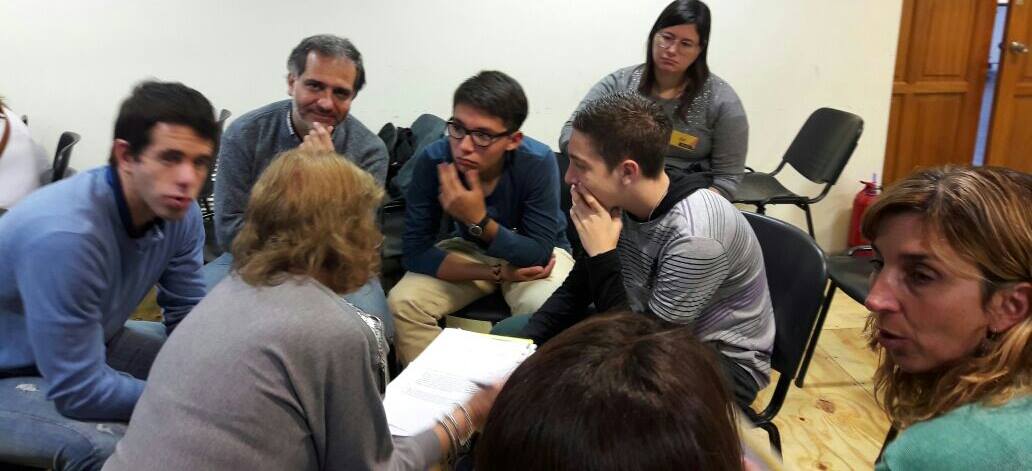
7 Jun 2017 | Focolare Worldwide
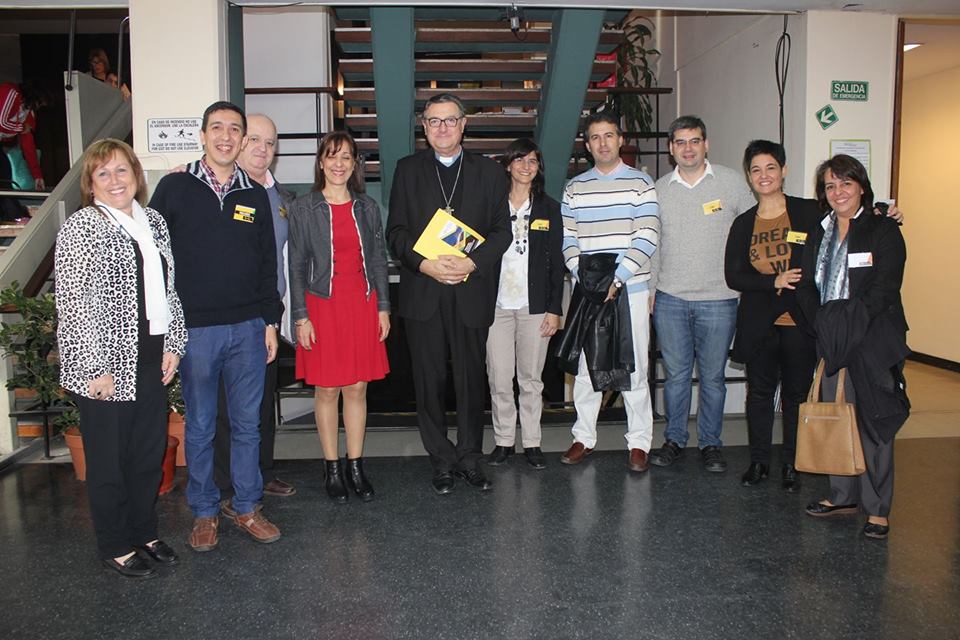 «This is not just a meeting for educators», one of the participants commented with emotion. «I am no longer the same person I was when I got here». «Fraternity, as a lifeoption is the blood that must run in my veins.» There were some impressions of the many participants from countries of the Southern Conethat gathered from 12-14 May in Rosario, Argentina. Besides these, about 500 educators took part directly via streaming during the various moments dedicated to the theme of the Meeting: “The service to learning service,” “Education for a fraternal economy,” “Inter-generational dialogue, and “Empathy and intercultural Workshop” to name a few. The first day started with the visit of the Governor of Santa Fe, Miguel Lifschitz, and authorities of the other local institutions. The Archbishop of Rosario, Bishop Martin, gave a speech the day after and started by affirming that the word,“fraternity,” says that we are not alone.«In this country God brought us together and the challenge we had before is called coexistence…You are not only diffusing theories but you start off from life, and concrete facts.» What came to light was not only the life of fraternity between the students and with their teachers but also between directors and inspectors, proposing innovations for the benefit of the entire educational community. The schools with artistic orientations and which had adhered to the objective of brotherhood gave their testimonials on how interculturality is lived through art, demonstrating new ways of interpreting life as artists. The workshop on inclusion helped to clarify the concept of how “the other, with all his differences is a gift.”
«This is not just a meeting for educators», one of the participants commented with emotion. «I am no longer the same person I was when I got here». «Fraternity, as a lifeoption is the blood that must run in my veins.» There were some impressions of the many participants from countries of the Southern Conethat gathered from 12-14 May in Rosario, Argentina. Besides these, about 500 educators took part directly via streaming during the various moments dedicated to the theme of the Meeting: “The service to learning service,” “Education for a fraternal economy,” “Inter-generational dialogue, and “Empathy and intercultural Workshop” to name a few. The first day started with the visit of the Governor of Santa Fe, Miguel Lifschitz, and authorities of the other local institutions. The Archbishop of Rosario, Bishop Martin, gave a speech the day after and started by affirming that the word,“fraternity,” says that we are not alone.«In this country God brought us together and the challenge we had before is called coexistence…You are not only diffusing theories but you start off from life, and concrete facts.» What came to light was not only the life of fraternity between the students and with their teachers but also between directors and inspectors, proposing innovations for the benefit of the entire educational community. The schools with artistic orientations and which had adhered to the objective of brotherhood gave their testimonials on how interculturality is lived through art, demonstrating new ways of interpreting life as artists. The workshop on inclusion helped to clarify the concept of how “the other, with all his differences is a gift.” 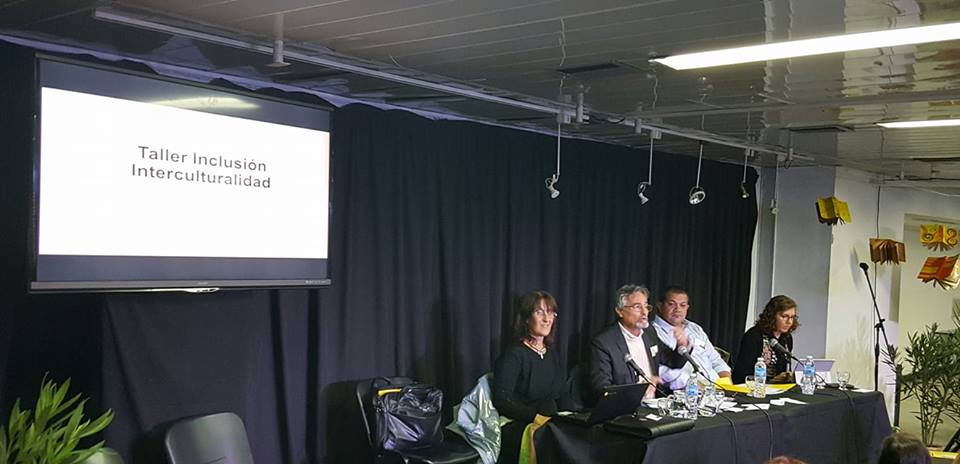 The theme on education and training outside the school environment, which is a life-learning process focusing on brotherhood as its methodology, indicated a pathway which consists in going out towards the peripheries with a programme centered on values. The experiences on the relationship between education and technology were presented as the great opportunity to achieve fraternity, setting the relationship between students and that with the teachers on the same level, and as the possibility to bring out the best in the others, and learn from everyone. Also many educational practices that had produced excellent results were presented, and concerned the potential of body language and the golden rule in the field of sports as a way of building bridges in such important fields.
The theme on education and training outside the school environment, which is a life-learning process focusing on brotherhood as its methodology, indicated a pathway which consists in going out towards the peripheries with a programme centered on values. The experiences on the relationship between education and technology were presented as the great opportunity to achieve fraternity, setting the relationship between students and that with the teachers on the same level, and as the possibility to bring out the best in the others, and learn from everyone. Also many educational practices that had produced excellent results were presented, and concerned the potential of body language and the golden rule in the field of sports as a way of building bridges in such important fields.  All this can be summarized in Chiara Lubich’s educational proposal to be applied in many educational realities worldwide, inspired by love for the more vulnerable, “ignorant,” abandoned people who are excluded from the system. It is a path that identifies the presence of Jesus Crucified and Abandoned: an abandonment that found its answer of love in the Resurrection, which is thus a key to building fraternity right in the heart of the “divide.” «I leave with my heart full of hope knowing that this paradigm exists, knowing that there are a lot of people working to combat verticality, the lack of mutual listening, the widespread mentality for which knowledge is only in the hands of the teacher, the adult – said Enzo of Chacabuco, specialized in music therapy. – This is a different road. I hope the second edition of this Convention will be organised soon.» Source: SiteSouthern Cone
All this can be summarized in Chiara Lubich’s educational proposal to be applied in many educational realities worldwide, inspired by love for the more vulnerable, “ignorant,” abandoned people who are excluded from the system. It is a path that identifies the presence of Jesus Crucified and Abandoned: an abandonment that found its answer of love in the Resurrection, which is thus a key to building fraternity right in the heart of the “divide.” «I leave with my heart full of hope knowing that this paradigm exists, knowing that there are a lot of people working to combat verticality, the lack of mutual listening, the widespread mentality for which knowledge is only in the hands of the teacher, the adult – said Enzo of Chacabuco, specialized in music therapy. – This is a different road. I hope the second edition of this Convention will be organised soon.» Source: SiteSouthern Cone






 My path began on the last day of the Rwandan calendar, the day in which we remember the massacre that happened in 1994. I know that
My path began on the last day of the Rwandan calendar, the day in which we remember the massacre that happened in 1994. I know that 

 The theme on education and training outside the school environment, which is a life-learning process focusing on brotherhood as its methodology, indicated a pathway which consists in going out towards the peripheries with a programme centered on values. The experiences on the relationship between education and technology were presented as the great opportunity to achieve fraternity, setting the relationship between students and that with the teachers on the same level, and as the possibility to bring out the best in the others, and learn from everyone. Also many educational practices that had produced excellent results were presented, and concerned the potential of body language and the golden rule in the field of sports as a way of building bridges in such important fields.
The theme on education and training outside the school environment, which is a life-learning process focusing on brotherhood as its methodology, indicated a pathway which consists in going out towards the peripheries with a programme centered on values. The experiences on the relationship between education and technology were presented as the great opportunity to achieve fraternity, setting the relationship between students and that with the teachers on the same level, and as the possibility to bring out the best in the others, and learn from everyone. Also many educational practices that had produced excellent results were presented, and concerned the potential of body language and the golden rule in the field of sports as a way of building bridges in such important fields.